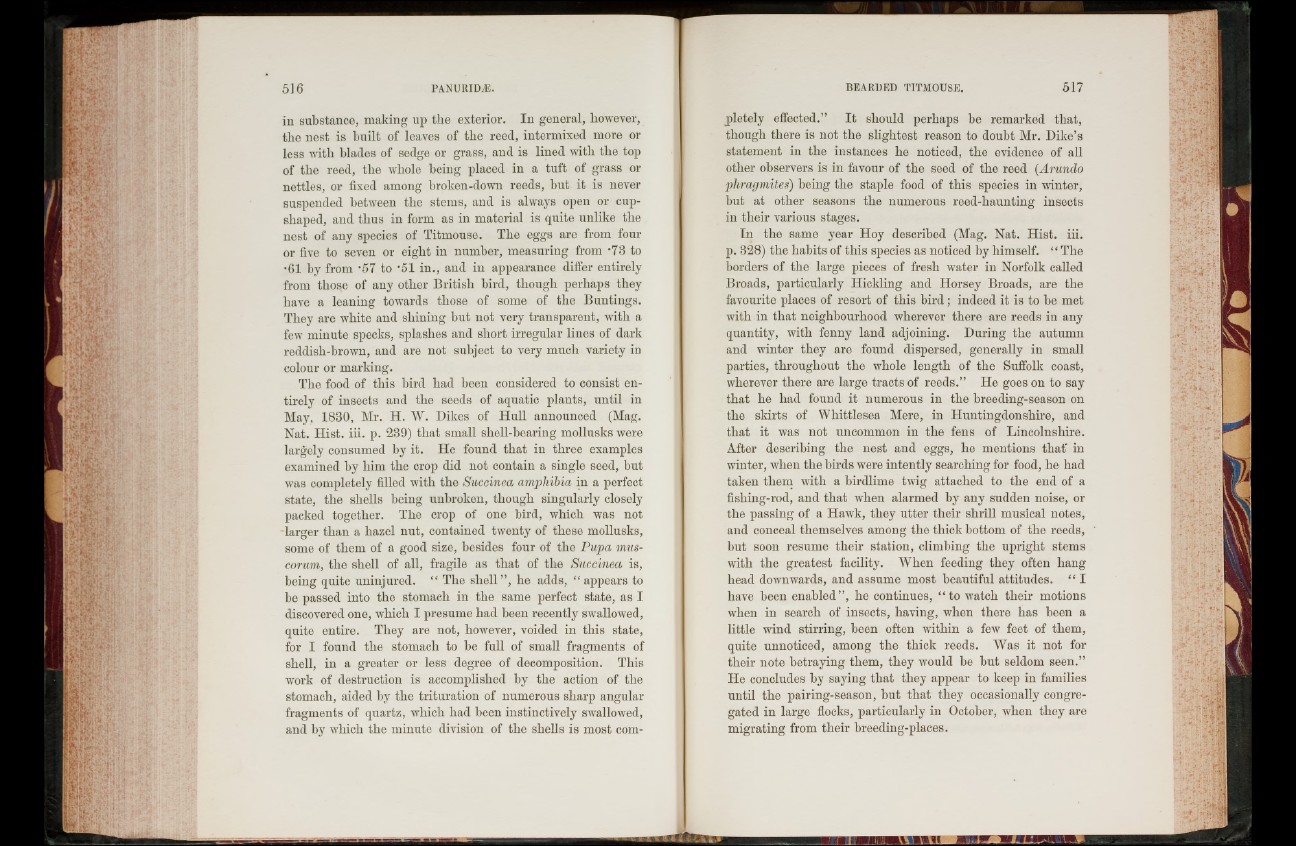
in substance, making up the exterior. In general, however,
the nest is built of leaves of the reed, intermixed more or
less with blades of sedge or grass, and is lined with the top
of the reed, the whole being placed in a tuft of grass or
nettles, or fixed among broken-down reeds, but it is never
suspended between the stems, and is always open or cup-
sliaped, and thus in form as in material is quite unlike the
nest of any species of Titmouse. The eggs are from four
or five to seven or eight in number, measuring from ‘73 to
•61 by from '57 to '51 in., and in appearance differ entirely
from those of any other British bird, though perhaps they
have a leaning towards those of some of the Buntings.
They are white and shining but not very transparent, with a
few minute specks, splashes and short irregular lines of dark
reddish-brown, and are not subject to very much variety in
colour or marking.
The food of this bird had been considered to consist entirely
of insects and the seeds of aquatic plants, until in
May, 1830, Mr. H. W. Dikes of Hull announced (Mag.
Nat. Hist. iii. p. 239) that small shell-bearing mollusks were
largely consumed by it. He found that in three examples
examined by him the crop did not contain a single seed, but
was completely filled with the Succinea amphibia in a perfect
state, the shells being unbroken, though singularly closely
packed together. The crop of one bird, which was not
larger than a hazel nut, contained twenty of these mollusks,
some of them of a good size, besides four of the Pupa mus-
corum, the shell of all, fragile as that of the Succinea is,
being quite uninjured. “ The shell ”, he adds, “ appears to
be passed into the stomach in the same perfect state, as I
discovered one, which I presume had been recently swallowed,
quite entire. They are not, however, voided in this state,
for I found the stomach to be full of small fragments of
shell, in a greater or less degree of decomposition. This
work of destruction is accomplished by the action of the
stomach, aided by the trituration of numerous sharp angular
fragments of quartz, which had been instinctively swallowed,
and by which the minute division of the shells is most completely
effected.” I t should perhaps be remarked that,
though there is not the slightest reason to doubt Mr. Dike’s
statement in the instances he noticed, the evidence of all
other observers is in favour of the seed of the reed (Aruiulo
phragmites) being the staple food of this species in winter,
but at other seasons the numerous reed-haunting insects
in their various stages.
In the same year Hoy described (Mag. Nat. Hist. iii.
p. 328) the habits of this species as noticed by himself. “ The
borders of the large pieces of fresh water in Norfolk called
Broads, particularly Hickling and Horsey Broads, are the
favourite places of resort of this b ird ; indeed it is to be met
with in that neighbourhood wherever there are reeds in any
quantity, with fenny land adjoining. During the autumn
and winter they are found dispersed, generally in small
parties, throughout the whole length of the Suffolk coast,
wherever there are large tracts of reeds.” He goes on to say
that he had found it numerous in the breeding-season on
the skirts of Wliittlesea Mere, in Huntingdonshire, and
that it was not uncommon in the fens of Lincolnshire.
After describing the nest and eggs, he mentions that" in
winter, when the birds were intently searching for food, he had
taken them with a birdlime twig attached to the end of a
fishing-rod, and that when alarmed by any sudden noise, or
the passing of a Hawk, they utter their shrill musical notes,
and conceal themselves among the thick bottom of the reeds,
but soon resume their station, climbing the upright stems
with the greatest facility. When feeding they often hang
head downwards, and assume most beautiful attitudes. “ I
have been enabled” , he continues, “ to watch their motions
when in search of insects, having, when there has been a
little wind stirring, been often within a few feet of them,
quite unnoticed, among the thick reeds. Was it not for
their note betraying them, they would be but seldom seen.”
He concludes by saying that they appear to keep in families
until the pairing-season, but that they occasionally congregated
in large flocks, particularly in October, when they are
migrating from their breeding-places.